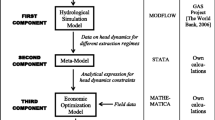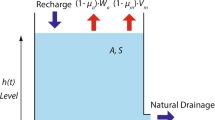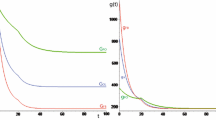Abstract
Standard economic models of groundwater management impose restrictive assumptions regarding perfect transmissivity (i.e., the aquifer behaves as a bathtub), no external effects of groundwater stocks, observability of individual extraction rates, and/or homogeneous agents. In this article, we derive regulatory mechanisms for inducing the socially optimal extraction path in Markov perfect equilibrium for aquifers in which these assumptions do not hold. In spite of the complexity of the underlying system, we identify an interesting case in which a simple linear mechanism achieves the social optimum. To illustrate potential problems that can arise by erroneously imposing simplifying assumptions, we conduct a simulation based on data from the Indian state of Andhra Pradesh.
Similar content being viewed by others
References
Aggarwal RM, Narayan TA (2004) Does inequality lead to greater efficiency in the use of local commons? The role of strategic investments in capacity. J Environ Econ Manag 47: 163–182
Athanassoglou S (2010) Dynamic nonpoint source pollution control policy: ambient transfers and uncertainty. J Econ Dyn Control 34: 2494–2509
Brozović N, Sunding DL, Zilberman D (2006) Optimal management of groundwater over space and time. In: Berga D, Goetz R (eds) Frontiers in water resource economics, vol. 29 of natural resource management and policy series. Springer, Berlin
Brozović N, Sunding DL, Zilberman D (2010) On the spatial nature of the groundwater pumping externality. Resour Energy Econ 32: 154–164
Burton TA (2005) Volterra integral and differential equations, 2nd edn. Elsevier, Amsterdam
Chakravorty U, Umetsu C (2003) Basinwide water management: a spatial model. J Environ Econ Manag 45: 1–23
Coddington C, Carlson R (1997) Linear ordinary differential equations. SIAM, Philadelphia
Dasgupta P (2001) Human well-being and the natural environment. Oxford University Press, Oxford
Dockner E, Jorgensen S, van Long N, Sorger G (2000) Differential games in economics and management science. Cambridge University Press, Cambridge
Dubash ND (2007) The electricity-groundwater conundrum: case for a political solution to a political problem. Econ Polit Weekly 42(52):45–55
Eswaran M, Lewis T (1984) Appropriability and the extraction of a common property resource. Economica 51: 393–400
Fisher A, Rubio S (1997) Adjusting to climate change: implications of increased variability and asymmetric adjustment costs for investment in water reserves. J Environ Econ Manag 34: 207–227
Gisser M, Sánchez DA (1980) Competition versus optimal control in groundwater pumping. Water Resour Res 16(4): 638–642
Harbaugh A (2005) MODFLOW-2005. The U.S. geological survey modular ground-water model–the ground-water flow process. Technical report 6-A16, U.S. Geological survey techniques and methods
Hirmajer T, Balsa-Canto E, Banga JR (2008) Dotcvp: dynamic optimization toolbox with control vector parameterization approach for handling continuous and mixed-integer dynamic optimization problems. Technical report. Instituto de Investigaciones Marinas
Karp L (2005) Nonpoint source pollution taxes and exessive tax burden. Environ Resour Econ 31(2): 229–251
Khalatbari F (1977) Market imperfections and the optimum rate of depletion of natural resources. Economica 44: 409–414
Negri DH (1989) The common property aquifer as a differential game. Water Resour Res 25(1): 9–15
Polyanin AD, Manzhirov AV (2008) Handbook of integral equations, 2nd edn. Chapman and Hall, London
Raj P (2004) Groundwater resources, 2004–05, Andhra Pradesh. Technical report. Groundwater Department, Government of Andhra Pradesh, India
Reddy V (2005) Costs of resource depletion externalities: a study of groundwater overexploitation in Andhra Pradesh. Environ Dev Econ 10: 533–556
Roseta-Palma C, Xepapadeas A (2004) Robust control in water management. J Risk Uncertain 29: 21–34
Rubio SJ, Casino B (2003) Strategic behavior and efficiency in the common property extraction of groundwater. Environ Resour Econ 26: 73–87
Rudin W (1976) Principles of mathematical analysis. McGraw-Hill, New York
Segerson K (1988) Uncertainty and incentives for nonpoint-source pollution control. J Environ Econ Manag 15: 87–98
Sethi SP, Thompson G (2000) Optimal control theory: applications to management science and economics, 2nd edn. Springer, Berlin
Shah T (2008) Taming the anarchy: groundwater governance in South Asia. RFF Press, Washington, DC
Shah T, Scott CA, Kishore A, Sharma A (2007) Energy–irrigation nexus in South Asia: Improving groundwater conservation and power sector viability. In: Giordano M, Villholth KG (eds) The agricultural groundwater revolution: opportunities and threats to development. CABI and International Water Management Institute, chap 11
Shiferaw B, Reddy VR, Wani SP (2008) Watershed externalities, shifting cropping patterns and groundwater depletion in Indian semi-arid villages: the effect of alternative water pricing policies. Ecol Econ 67: 327–340
van der Ploeg F (2011) Rapacious resource depletion, excessive investment and insecure property rights: a puzzle. Environ Resour Econ 48: 105–128
World Bank (2001) India, power supply to agriculture, volume 1: summary report. Technical report. 22171-IN, Energy Sector Unit, South Asia Regional Office
Xepapadeas A (1992) Environmental policy and dynamic nonpoint-source pollution. J Environ Econ Manag 23: 22–39
Zeitouni N, Dinar A (1997) Mitigating negative water quality and quality externalities by joint management of adjacent aquifers. Environ Resour Econ 9: 1–20
Author information
Authors and Affiliations
Corresponding author
Additional information
The views expressed herein are those of the authors and not necessarily the U.S. Environmental Protection Agency.
Rights and permissions
About this article
Cite this article
Athanassoglou, S., Sheriff, G., Siegfried, T. et al. Optimal Mechanisms for Heterogeneous Multi-Cell Aquifers. Environ Resource Econ 52, 265–291 (2012). https://doi.org/10.1007/s10640-011-9528-0
Accepted:
Published:
Issue Date:
DOI: https://doi.org/10.1007/s10640-011-9528-0




